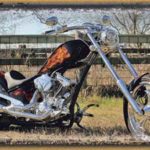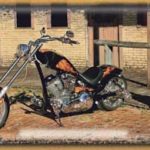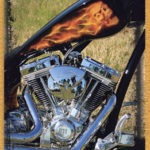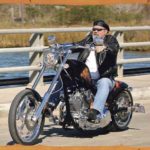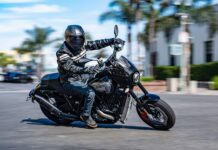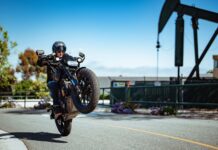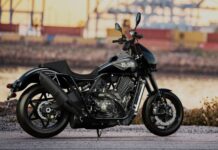A brand new rodeo
Bucking the challenges
The last time I had any saddle time aboard a Texas Chopper was in the spring of 2006 during Daytona Bike Week. It served as a most excellent mount and garnered its share of attention. A few months later, American IronHorse headquarters in Fort Worth held a press launch for their 2007 models. At that time, the heavily reconfigured Slammer was unveiled. It was a radical design change from previous Slammers. So much so that it left competitors scrambling to rethink their own platforms. Now, they’ve done it again; the 2008 Texas Chopper is a cut above anything in this bloodline before it. In other words, this is one new pony.
Thinning the herd
Last year, during the 2007 V-Twin Expo in Cincinnati, American IronHorse introduced their Rally Series, three new models designed to appeal to a conservative customer base with a modest budget. They were the Bandera, the Classic Chop and the Judge. At that time, all six of their high-end models were also still listed on the roster: the Texas Chopper and the Slammer along with the Legend, the Tejas, the Outlaw and the LSC. But nine models would prove to be about four too many, due to the vacillating American motorcycle market. For 2008, the Rally Series has been retained along with the Texas Chopper and the Slammer. Those with the lowest sales figures were put out to pasture and all efforts are now being concentrated on refining the remaining models. This breeding program has resulted is the finest Texas Chopper ever to roll out of North Texas.
The good folks over at Xtreme Texas Choppers had volunteered to supply my test steed for this review. There I met GM Lowe Tyring who gave me the grand tour. Located along the coast in Bacliff, just north of Galveston, XTC is more of a biker complex than a shop, incorporating a showroom, a fully equipped service center and an apparel department with a tattoo shop conveniently located next door. In the building right behind the shop is XTC’s Mother’s Speakeasy Bar & Grill that features Texas Hold ’Em poker tournaments, live bands and a continuous stream of two-wheeled patrons. There are even plans in the works to initiate an American IronHorse rental facility later this year. Busy place.
Lowe gave me the rundown on some of the changes in the new Texas Chopper, with the two most noticeable being the frame and gas tank. The frame is an elegant work of art with a low profile drop-seat design that cradles the rider in the bike instead of aboard it, with a scant 22″ of seat height. On this machine almost any rider will sit flat-footed with their knees bent. A massive 2″ diameter single downtube is featured this year with a slight curve that adds to the styling and allows ample display of the motor. For ’08, AIH designers have eliminated one of the highly recognizable Texas Chopper components and replaced their signature stretched tank with what they term an “SS-2” Chopper Tank. This attractive tank is deceptive in size and amazingly holds five gallons of petrol. The front end remains at 12″ over stock length and retains the rake it’s had for years: 42 degrees. And while the front end has kept much of its original design (90mm tire on a 21″ rim nestled between a set of polished lower legs), the rear section has received a major face-lift with a 300mm tire replacing last year’s 280 and a new LW-1 Stealth swingarm that’s been lengthened by 2″ to provide clearance for the rubber and to aid in handling. Now I’ve never been a big fan of a tire that big but I remembered the great handling of that Texas Chopper in Daytona, so what’s another 3/4″? And then… then it started raining.
One big hoof print
Lowe was standing in the doorway of the shop, watching the test bike get soaked while I was calculating in my head the best rain route for the 80-mile trip back to the office. Lowe gave me one of those, “You sure you’re up for this?” looks and I’ll admit, I would have just as soon turned around right then and taken up residence at a corner table inside Mother’s Speakeasy rather than tackle a wet ride on a new bike. But downing a cold one with a chaser of whiskey probably wouldn’t have offered Mr. GM much reassurance. Instead I donned my jacket, full-face helmet and gloves and went out to play in the rain. I selected the most direct route—all freeway. And like a surgeon I sliced a path through the heart of downtown Houston using a 12-foot-long barking mechanical monster as my scalpel. The first thing I noticed was just how much surface water a 300mm tire can throw. Not only was I riding into the rain but also into the spray that was being tossed over my head and ahead of me. No, that abbreviated rear fender doesn’t catch much, but my chase pilot later confided that a 10-foot rooster tail at 70 mph sure looked cool.
In an apparent effort to reduce costs by reducing excess inventory, all American IronHorse motorcycles are now powered exclusively by a 111 c.i. S&S motor (the 117 c.i. and 124 c.i. are no longer options). And except for the Slammer, all models are still carbureted with an S&S Super E. The fuel injection system available on the Slammer will probably be integrated in the entire production line by next year. The motor feeds power to the 6-speed right-side-drive transmission via a chain-driven enclosed primary system. The exhaust gases are handled by a dyno-tuned, two-into-one collector with integral heat shields. The air cleaner cover is the company’s striking teardrop design that is also carried over onto the coil cover on the left side of the bike. My test machine was equipped with AIH Street Fighter polished mags that were further enhanced with matching carriers on the brake rotors and the drive pulley—a very nice touch. The ends of the grips, footpegs, shifter peg and brake pedal are capped with identical chrome finials.
The graphics package on my ride was black with true flames and a fiery skull on either side of the gas tank. Its official name is “The Sinner” but more than once it was referred to as “Ghost Rider” by admiring onlookers. AIH presently offers 50 graphic designs in their paint gallery along with a myriad of base color options to assure the ultimate in customized variety.
On the trail
The new drop-frame design places the rider’s butt on a plane equal with the top edge of that big ol’ fat 300, and the V-shaped drag bars come in just below shoulder height (for a person six feet tall). The placement of the pegs and forward controls is a comfortable reach with shifting and braking easily accomplished. Although that rear rubber is intimidating, the seating position is so well executed that most riders will have no problem adjusting to the skills required to break that donut free from its natural gyroscopic properties while negotiating a sweeper. Only during slow-speed corners is it necessary to actually “steer” the front end and even that soon becomes second nature. And despite the single downtube, there is absolutely no flex in the frame. Some of my photo shoots were slightly off-road and I wouldn’t have risked taking the bike anyplace I didn’t think it could handle. That’s right—I took this barhopper and turned it into a ditch-hopper.
The lower seating position also had an unexpected side benefit: I could actually read the instrument package most of the time. One of my biggest complaints with the AIH “information center” has always been the inability to read the digital speedo in bright sunlight situations. Lowering the rider so that the housing is nearly at eye level makes a huge difference in visibility. The 111-inch motor pulls strong in all gears with 6th being reserved for speeds above 60 mph. (Even at that speed in 5th gear, the rpm stayed well below 3,000.) And the four-piston brake system had no problems in quickly hauling this big boy down to a full stop without any jitters over loss of stability. The hydraulic “Easy-Pull” clutch is aptly named, having one of the lightest touches I’ve ever encountered. And while the “Illuminati” headlight provides more than ample lighting up front, the twin LED taillights cast an amazing amount of luminosity for their size (they also double as turn signals).
Near-perfect pony
Only two negative aspects stood out during my week of asphalt pounding on the Texas Chopper. While the dropped seat offers great stability and handling characteristics, it needs more padding. With my feet on the pegs and hands on the bars, my butt tended to get “pinched” down into a point in the seating bucket. And since I’ve got a classic Texas cowboy behind (mostly just a piece of hide stretched across a pelvic bone) and an even more classic Texas cowboy beer gut (I weigh in at 230), my rear tended to need a break after about 100 miles, depending on the road conditions. So I suggest either an increase in the padding on the seat or I need to grow a heartier butt. (Losing those extra pounds above my belt buckle might be an alternative, but that’s last on the list.)
The second item also has to do with the drop-frame design. Lowering the seat area left only enough space between the seat pan and the starter for the bike’s electrics and battery. They are enclosed behind a two-piece plastic cover, a graceful thing of beauty with curves and cuts that mates perfectly with the bike’s character (it’s also the location for the ignition switch cavity). The relocation of the oil tank proved to be one of the coolest (but by far the most impractical) features of this bike. Positioned just behind the swingarm pivot assembly and just in front of the rear tire, the 3 1/2-quart oil tank is painted to match the swingarm and neatly tucked out of view; only the filler cap reveals its purpose. When it came time to check the level, I unscrewed the cap and immediately lost half a cup of oil on the driveway. I quickly replaced the cap and checked to see if there was possibly another point to check the level, thinking that maybe the cap was only for replenishing the tank supply. But there isn’t. To check the oil, the bike must be stood perfectly upright and off the kickstand, making this a two-man operation. Some type of dipstick or level indicator is sorely needed.
This 2008 Texas Chopper as tested with the graphics upgrade carries an MSRP of $34,249 (standard solid color without graphics goes for $31,999 MSRP). Combined with the lowered seating position and the extra large rear rubber, the extra splash of artwork definitely sets the bike apart in a crowd and grabs the attention of both biker and nonrider alike. With years of experience behind them, American IronHorse has figured out how to remain a viable player during the country’s recent economic downturn without compromising on quality or innovation.





